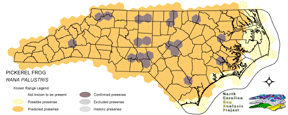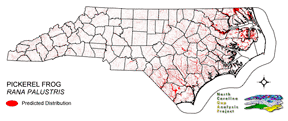
| Taxa: |
| Order: |
| Family: |
| Amphibia |
| Anura |
| Ranidae |
| NatureServe Global Rank: |
| NatureServe State (NC) Rank: |
| G5 |
| S5 |
| Federal Status: |
| NC State Status: |
| --- |
| --- |


| Land Unit |
| US Fish & Wildlife Service |
| US Forest Service |
| US National Park Service |
| US Department of Defense |
| NC State Parks |
| NC University System |
| NC Wildlife Res. Com. |
| NC Forest Service |
| NC Div. of Coastal Mgmt. |
| Local Governments |
| Non-Governmental Org. |
| Other Public Lands |
| Private Lands |
| GAP Status 1-2 |
| All Protected Lands |
| Statewide |
| Hectares |
| 60,853.23 |
| 40,062.42 |
| 23,411.88 |
| 10,563.75 |
| 13,817.61 |
| 6,006.06 |
| 29,336.85 |
| 2,992.05 |
| 5,748.48 |
| 1,316.43 |
| 14,733.00 |
| 486.63 |
| 1,046,015.28 |
| 127,818.99 |
| 207,214.38 |
| 1,255,343.67 |
| Acres |
| 150,371.58 |
| 98,996.38 |
| 57,852.00 |
| 26,103.59 |
| 34,144.05 |
| 14,841.29 |
| 72,492.92 |
| 7,796.94 |
| 14,204.80 |
| 3,252.97 |
| 36,406.03 |
| 1,202.49 |
| 2,584,759.54 |
| 316,250.97 |
| 512,441.21 |
| 3,102,424.58 |
| % of Dist. on |
| Prot. Lands |
| 29.4 % |
| 19.3 % |
| 10.4 % |
| 5.1 % |
| 6.7 % |
| 2.9 % |
| 14.1 % |
| 1.4 % |
| 2.8 % |
| 7.1 % |
| 7.1 % |
| < 0.1 % |
| 0.1 % |
| 61.7 % |
| ----- |
| ----- |
| % of Dist. on |
| All Lands |
| 4.8 % |
| 3.2 % |
| 1.9 % |
| 0.8 % |
| 1.1 % |
| 0.5 % |
| 2.3 % |
| 0.2 % |
| 0.5 % |
| 0.1 % |
| 1.2 % |
| < 0.1 % |
| 83.3 % |
| 10.2 % |
| ----- |
| ----- |
|
Pickerel frogs are usually found in or near woodlands where they inhabit springs, creeks, ponds, reservoirs, floodplain swamps and the twilight zone of caves (Martof et al. 1980, Wilson 1995, Conant and Collins 1998). Associated with forested wetlands as breeding sites, primarily creeks and slow flowing water, but will also breed in ponds and streams of old
field & shrub habitat. In the coastal plain, it is most commonly found in bottomland swamps and forest edged marshes. In the piedmont and mountains, typical habitat is cool densely forest riparian ravines, also wet meadows near hardwood forest. Conant (1975) describes its habitat as sphagnum bogs, rocky ravines, and meadow streams. NATURE SERVE GLOBAL HABITAT COMMENTS: Various habitats in wooded regions; vicinity of cool clear streams and ponds in north; warm, turbid swamps in parts of south. Disperses from water's edge into fields and woods in some regions. When inactive, hides at bottom of water body or in caves in some areas. Eggs and larvae develop in standing water of woodland ponds, bog ponds, stream pools, sloughs, and flooded ditches; often in sites with few or no fishes (e.g., Holomuzki 1995). |
| Code | Name | Description | NC Natural Heritage Program Equivalent |
| 75 | Tidal Swamp Forest | Swamp tupelo dominated forest with or without black tupelo and/or cypress trees. Restricted to the tidal zones in the coastal plain. May have inclusions of coastal red cedar woodlands. | Tidal cypress - gum swamp |
| 126 | Interdune Wooded Depression Swamp | Includes swamps dominated by sweetbay and swampbay or dogwood dominated forests. | Maritime Shrub Swamp, Maritime Swamp Forest |
| 380 | Coastal Plain Fresh Water Emergent | Emergent vegetation in fresh water seepage bogs, ponds and riverbeds of the coastal plain. Includes alliances dominated by sedges, eelgrass, as well as cane found in unforested cane-brakes. | Small Depression Pond, Sandhill Seep, Floodplain Pool, Unforested Floodplain Canebrake, Riverscour Prairies, Vernal Pools |
| 173 | Coastal Plain Riverbank Shrubs | Shrub dominated riverbanks, commonly dominated by willows and/or alders. | Sand and Mud Bar |
| 50 | Coastal Plain Mixed Bottomland Forests | Includes forests dominated by a variety of hardwood species, including sweetgum, cottonwood, red maple. | Coastal Plain Bottomland Hardwood (in part), Coastal Plain Levee Forest |
| 49 | Coastal Plain Oak Bottomland Forest | Bottomland forests dominated by deciduous oak alliances. Oaks represented can include swamp chestnut, cherrybark, willow, and/or overcup oak. Inclusions of loblolly pine temporarily flooded forests occur in patches. Hydrology is temporarily to seasonally flooded. | Coastal Plain Bottomland Hardwoods (in part) blackwater subtype, brownwater subtype |
| 158 | Coastal Plain Nonriverine Wet Flat Forests | Loblolly pine - Atlantic white-cedar - red maple - swamp tupelo saturated forests as well as forests dominated by loblolly, sweetgum, and red maple in non-riverine flats. | Non-riverine Wet Hardwood Forest |
| 41 | Peatland Atlantic White-Cedar Forest | Dense stands of Atlantic white cedar with saturated hydrology. Can include swamp tupelo, red maple, and pond pines with a moderate shrub and herb layer. | Peatland Atlantic White-Cedar Forest |
| 15 | Seepage and Streamhead Swamps | Includes extensive peat flats in the coastal plain, dominated by swamp tupelo, maples, and Atlantic white cedar alliances. In the sandhills includes streamhead pond pine and bay forests alliances. Saturated hydrology. | Bay Forest, Small Depression Pocosin, Streamhead Atlantic White Cedar Forest, Streamhead Pocosins |
| 30 | Cypress-Gum Floodplain Forests | Swamps dominated by black or swamp tupelo with or without Taxodium. Seasonally to semi-permanently flooded hydrology. | Cypress-Gum Swamps |
| 78 | Pond-Cypress - Gum Swamps, Savannas and Lakeshores | Cypress dominated swamps and lakeshores. Can include bays dominated by pond cypress or shorelines of coastal plain lakes with a narrow band of cypress. | Non-riverine Swamp Forest, Natural Lakeshores (in part) |
| 385 | Oak Bottomland Forest and Swamp Forest | The swamp chestnut oak, cherrybark oak, shumard oak and sweetgum alliance is one representative. Other alliances are dominated by water, willow, and overcup oaks. Swamp forests can be dominated by sweetgum, red maple, and black gum being dominant. Loblolly can occur in combination with sweetgum and red maple, or with tulip poplar. Includes saturated and semi- to permanently flooded forests in the mountains. | Piedmont/Mountain Bottomland Forest, Piedmont/Mountain Swamp Forest |
| 238 | Piedmont/Mountain Submerged Aquatic Vegetation | Seasonally to permanently flooded areas with aquatic vegetation. Waterlily, pondweed, hydrilla smartweed are a few of the species that can occur. | Piedmont/Mountain Semipermanent Impoundment (in part) |
| 239 | Piedmont/Mountain Emergent Vegetation | Emergent vegetation of all wetland hydrologies. Sites would commonly support species such as tussock sedge, rushs, and cattail alliances. | Rocky Bar and Shore (in part) |
| 267 | Riverbank Shrublands | Riverside shrubs with temporarily flooded hydrologies. Found in the both the Mountains and Piedmont. Containing dominants such as smooth alder and a Carolina or black willows. | Sand and Mud Bar |
| 269 | Floodplain Wet Shrublands | Saturated shrublands of the Piedmont, includes buttonbush, swamp-loosestrife, decodon and alders. | Piedmont/mountain Semipermanent Impoundment |
| 384 | Piedmont/Mountain Mixed Bottomland Hardwood Forests | Includes temporarily to seasonally forests dominated by hardwood species. Hardwoods include sweetgum, red maple, sycamore which co-occur in a mosaic of bottomland and levee positions. Includes alluvial hardwood forests in the mountains. Hemlock and white pine may occur as inclusions, but are generally mapped separately. | Piedmont/Mountain Alluvial Forest, Piedmont/Mountain Levee Forest |
| 8 | Open water | Open water without aquatic vegetation. | No equivalent |
| 517 | Hemlock Floodplain Forest | Alluvial forest with hemlock and/or white pine in mountains and western piedmont. Hydrology is generally temporarily to seasonally flooded. | Canada Hemlock Forest |
| 522 | Northern Hardwoods | High Elevation forests including yellow birch, American beech, and yellow buckeye. Includes forests with Hemlock and Yellow Birch. | Northern Hardwoods Forest, Boulderfield Forest |
| 525 | Appalachian Oak Forest | A variety of oak forest types including Black, White, Scarlet Oaks in dry to mesic situations. Includes forests historically co-dominated by American Chestnut. | High Elevation Red Oak Forest, Montane White Oak Forest |
| 526 | Appalachian Cove Forest | Mixed Mesophytic forests of the mountains. Includes tuliptree, basswood, yellow buckeye and surgar maple. This class is mapped to include cove forests dominated or co-dominated by hemlock. | Rich Cove Forest, Acidic Cove Forest |
| 527 | Appalachian Hemlock | Upland hemlock forests of the moutains region. Vary from side slopes to steep slope positions. | Canada Hemlock Forest |
| 533 | Appalachian Swamp Forest | Evergreen and deciduous forests with saturated hydrologies. This class may contain a variety of trees species, including hemlock - red maple, pitch pine, and white pine forests. | Swamp Forest-Bog Complex, Southern Appalachian Bog, Southern Appalachian Fen |
| 534 | Appalachian Wet Shrubland/ Herbaceous | Saturated shrubs and herbaceous vegetation. Often mapped as an inclusion in Appalachian Swamp Forest. | Southern Appalachian Bog, Southern Appalachian Fen |
|
Holomuzki, J. R. 1995. Oviposition sites and fish-deterrent mechanisms of two stream anurans. Copeia 1995:607-613.
Pace, A.E. 1974. Systematic and biological studies of the leopard frogs (Rana pipiens Complex) of the United States. Misc. Publ. Mus. Zool., Univ. Michigan 148:1-140. Wilson, L. A. 1995. The Land Manager's Guide to the amphibians and reptiles of the South. Chapel Hill, NC: The Nature Conservancy. Barbour, R. W. 1971. Amphibians and reptiles of Kentucky. Univ. Press of Kentucky, Lexington. x + 334 pp. Minton, S. A., Jr. 1972. Amphibians and reptiles of Indiana. Indiana Academy Science Monographs 3. v + 346 pp. Conant, R. 1975. A Field Guide to Reptiles and Amphibians of Eastern and Central North America. Second Edition. Houghton Mifflin Company, Boston, Massachusetts. xvii + 429 pp. Mount, R. H. 1975. The Reptiles and Amphibians of Alabama. Auburn University Agricultural Experiment Station, Auburn, Alabama. vii + 347 pp. Johnson, T. R. 1977. The amphibians of Missouri. Univ. Kansas Mus. Nat. Hist., Pub. Ed. Ser. 6. ix + 134 pp. Martof, B. S., W. M. Palmer, J. R. Bailey, and J. R. Harrison, III. 1980. Amphibians and reptiles of the Carolinas and Virginia. University of North Carolina Press, Chapel Hill, North Carolina. 264 pp. Vogt, R. G. 1981. Natural history of amphibians and reptiles of Wisconsin. Milwaukee Public Museum. 205 pp. DeGraaf, R. M., and D. D. Rudis. 1983. Amphibians and reptiles of New England. Habitats and natural history. Univ. Massachusetts Press. vii + 83 pp. Schaaf, R. T., Jr., and P. W. Smith. 1971. Rana palustris. Cat. Am. Amph. Rep. 117.1-117.3. |
For more information please contact them at:
NC-GAP Analysis Project
Dept. of Zoology, NCSU
Campus Box 7617
Raleigh, NC 27695-7617
(919) 513-2853
www.basic.ncsu.edu/ncgap